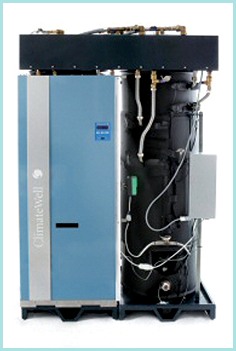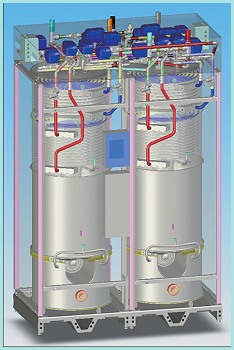| United
Nations |
| Positive
Commitment for Positive Climate Change |
From Supreme Master Television News, Episode 65
The United Nations Framework Convention on Climate Change (UNFCCC), held to implement positive solutions to global warming, took place in Nairobi, Kenya, from November 6-17, Golden Year 3 (2006), and was attended by more than 5,000 delegates. Kenya's Environment Minister, Kivutha Kibwana, urged negotiators to take concrete actions on immediate priorities. In response, the European Union pledged US$18 million towards reducing the effects of global warming over the next four years, especially in developing countries.
Italy vowed to lead by setting an example in making significant
improvements. New Zealand announced it would focus on positive changes
impacting agriculture and encouraged all nations to step forward and join
together in light of the Stern report by economist Sir Nicholas Stern,
'The Economics of Climate Change.' Kenyan Nobel Peace laureate, Wangari
Maathai, introduced the Billion Tree Campaign to plant a minimum of one
billion trees in Golden Year 4 (2007). United Nations Environment Program
Director, Achim Steiner, said the Billion Tree Campaign offers a direct
and straightforward path which all sectors of society can step down to
contribute to meet the climate change challenge. With such single-minded
devotion and wholehearted cooperation among all nations to solving the
global warming issue, improvement is surely in sight. ![]()
 |
 |
UNFCCC Logo |
UNFCCC Map - Green: UNFCCC Member;
Peach: UNFCCC Observer; Gray: Not party to UNFCCC |
References:
http://www.msnbc.msn.com/id/15587638
http://www.physorg.com/news82230854.html
http://www.playfuls.com/news_002845_ItalyVows_To_
Take_Lead_In_Kyoto_Protocol.html
http://www.hoovers.com/free/news/detail.xhtml?ArticleID=
20061109670.2_21ad0008b3220dc3
http://www.alertnet.org/thenews/newsdesk/LA383140.htm
| United
Kingdom |
| A
Way to Store Hydrogen |
From Supreme Master Television News, Episode 73
Hydrogen is quickly becoming a popular source of alternative
energy but the problem with all alternative energy is how do we store
it and how do we do it effectively? The University of Nottingham in the
United Kingdom has found a way to store large quantities of hydrogen in
small porous structures, leading to the obsoleteness of the expression
bigger is better. The scientists working on the new development
are Professor Martin
Schröder and his colleagues, Professor Neil Champness and Dr.
Hubberstey from the School of Chemistry, with Dr. Gavin Walker from the
School of Mechanical, Materials and Manufacturing Engineering at the University
of Nottingham. The breakthrough achieved by the professors could very
well bring the world closer to a more hydrogen-based fuel economy. ![]()
Reference:
http://www.innovations-report.com/html/reports/automotive/report-70899.html
Helping
Save the Planet through Home Improvements |
From Supreme Master Television News, Episode 64
According to a 2006 survey, almost a third of British householders
have carried out energy-saving improvements in their homes over the past
year. The home improvements are practical for the homeowners who ultimately
save money by cutting gas expenses and electric bills as well as contributing
to decreasing global warming by reducing carbon dioxide emissions. The
survey conducted by the Halifax Building Society reflects people's on-going
commitment to improving energy efficiency by thinking of the future of
the planet and the next generations to come. ![]()
UK
Hospitals Get Cash to Fight Global Warming |
News provided by Singapore News Group (Originally in English)
In its efforts to cut the nation's greenhouse gas emissions
as well as energy consumption, on January 4, Golden Year 4 (2007), the
British government announced a 100 million pound (about 193 million US
dollars) fund to help the National Health Service in the battle to curb
the global warming crisis. The money will go towards more energy efficient
appliances, building insulation and combined heat and power plants. This
will help hospitals and other health sector buildings cut carbon dioxide
emissions, increase energy efficiency and reduce energy consumption. ![]()
Reference:
http://news.scotsman.com/latest_uk.cfm?id=17082007
Avoid
Meat and Dairy to Help the Environment |
By Brisbane News Group, Australia (Originally in English)
Britain's environment minister Ben Bradshaw has publicly declared that cutting out meat would go a long way towards stabilizing climate change.
Mr. Bradshaw announced this as the UK government launched a new website advising consumers to help the planet by avoiding meat and dairy products, and vegetables grown out of season. The website states: "The production of meat and dairy products has a much bigger effect on climate change and other environmental impacts than that of most grains, pulses and outdoor fruit and vegetables."
The website http://www.direct.gov.uk/greenerfood explains that eating beef, lamb, chicken and dairy products contributes to global warming because of the energy and land required to raise them. Mr. Bradshaw also stated that food production is just as detrimental as private transport and housing, and that the Government was considering a labeling system for all food products, based on the farm-to-fork impact each product has on the environment.
The Greener Food website also mentions that: "Healthy eating is also important and many people could benefit from eating a larger proportion of fruit and vegetables and less saturated fat in their diet."
The UK is leading the world by example, using scientific facts
to inform people about the harmful impacts meat and dairy products have
on our environment. ![]()
 |
The Energy Saving Recommended logo in UK endorses products that are amongst the most energy efficient available. |
References:
http://www.thisislondon.co.uk/news/article-23383454-details/Britain+could+go+back+to+rationing/article.do
http://www.activeg.org/news/full_story.html?id=783
| EU
|
| EU
and Airlines to Take Positive Steps to Reduce Greenhouse Gas Emissions
|
From Supreme Master Television News, Episode 71
Aviation emissions are increasing rapidly. To help curb greenhouse gas emissions, all airlines coming or going from EU airports are now asked to participate in the EU's carbon-trading scheme. British Airways support the emissions trading as they found it the most effective way in terms of economy and environment to cut carbon dioxide emissions.
The first phase of the scheme aims at emissions from the power
sector and heavy industries, and the next phase will aim at the second
largest source: cars, ships and planes. The Environment Commission is
now working on the operation and allocation methods. ![]()
 |
 |
| Jet trails are part of the gases emitted by aircraft | British Airways is willing to participate in the EU's
Greenhouse Gas Emissions Trading Scheme. |
Reference:
http://www.euractiv.com/en/transport/eu-tell-airlines-reduce-climate-impact/article-159585
| USA
|
| World's
Largest Solar Farm |
From Supreme Master Television News, Episode 53
Two start-up companies in the US are teaming up with New Mexico
State to build one of the world's largest solar powered energy farms.
Located near Deming, New Mexico, it will be about 30 times larger than
the world's largest solar farm to date. The panels will cover about 3,200
acres and generate about 300 megawatts of natural energy, enough to light
up 240,000 homes (an incredible amount of light beam energy). The team
will make special light sensitive panels in a new factory, thus creating
new jobs. ![]()
Reference:
http://www.planetark.com/dailynewsstory.cfm/newsid/36162/story.htm
Wal-Mart
Uses Its Leading Market Position to Promote Energy-saving Light
Bulbs |
By Singapore News Group (Originally in English)
 |
 |
| Wal-Mart CEO Mr. Lee Scott | A Wal-Mart display of energy-saving fluorescent light bulbs in Secaucus, New Jersey, USA. |
Wal-Mart the giant discount retailer also unveiled an environmental plan to become a leader on issues like fuel efficiency, reducing both energy use and greenhouse gas emissions. Wal-Mart plans to spend $500 million a year to increase fuel efficiency in Wal-Mart's truck fleet by 25% over three years and doubling it within 10 years; reduce greenhouse gases by 20% in seven years; reduce energy use at stores by 3%; and cut solid waste from its U.S. stores and Sam's Clubs by 25% in three years.
Another way to cut energy consumption is to use the more efficient light bulbs that use much less electricity. Compared to the more widely used incandescent light bulbs, the new compact fluorescent bulbs consume 75% less electricity, last 10 times longer, produce 450 pounds fewer greenhouse gases from power plants and save consumers US$30 over the life of each bulb. Wal-Mart is determined to promote and see such bulbs installed in at least 100 million homes.
Having America's biggest company, with a huge customer base
and influence with suppliers, encouraging 200 million shoppers to save
energy has truly given the 'green' movement a strong boost. ![]()
References:
http://www.nytimes.com/2007/01/02/business/02bulb.html?ex=1325394000en
=7cdfdd70524b7590ei=5088partner=rssnytemc=rss&pagewanted=all
http://www.msnbc.msn.com/id/9815727/
| Japan
|
| Solar
Cells |
From Supreme Master Television News, Episode 60
Japan is currently the world's leading producer of solar cells.
Now one of its sunshine filled areas is becoming the center of its production.
Another benefit to the area is that it experiences fewer earthquakes than
other regions. Both Fiji Electric and Honda Motor Co. had been invited
to set up factories in the region by Kumamoto Prefecture. They hope to
build 100 million yen (US$846,600) worth of solar equipment and to have
solar cells shipped out by 2010. The companies hope that solar cells will
become a popular method of energy, as it is both cost-effective and environmentally
friendly.![]()
 |
Honda Soltec Co., Ltd. factory (artist's impression), established on December 1, Golden Year 3 (2006), to produce and sell solar cells in latter half of Golden Year 4 (2007) |
Reference:
http://www.asahi.com/english/Herald-asahi/TKY200611040149.html
| Singapore
|
| Green
Mark Program and Other Initiatives |
By Singapore News Group (Originally in English)
As part of the Singapore government's continual efforts to promote sustainable living practices for the island nation, the Building and Construction Authority (BCA) launched the Green Mark program two years ago in January Golden Year 2 (2005). Green Mark aims to encourage developers and building owners to adopt environment-friendly designs, technologies and practices. With a rating system that evaluates buildings for their environmental impact and performance, Green Mark's objectives are being achieved through the implementation of such technologies as energy-saving air-conditioning systems, water-saving technologies and solar power.
Currently in Singapore, 34 buildings have Green Mark certification, with the public sector taking the lead in embracing green building technology. Starting April 1, Golden Year 4 (2007), all new public buildings and those undergoing major renovation must have Green Mark certification. For example, all new flats built by the government-owned Housing Development Board, which is the largest housing developer in Singapore, will be Green Mark certified.
The government has also made a total pledge of S$70 million
(US$46.6 million), launching two other initiatives that encourage sustainable
development. First, developers can obtain cash incentives of up to S$3
million (US$2 million) per project from S$20 million (US$13.3 million)
that has been allocated to the Green Building Incentive Scheme. Second,
Singapore-based companies and individuals can also apply for grants from
a R&D fund of S$50 million (US$33.3 million) allocated for development
of green technologies in the building industry. ![]()
 |
Varsity Park Condominium (artist's impression), awarded Green Mark Gold |
 |
St. Regis Hotel & Residences (artist's impression), awarded Green Mark Gold Plus |
 |
The Sail@Marina Bay (artist's impression), awarded Green Mark Gold |
References:
1. Green Mark Incentive Guide - http://www.bca.gov.sg/GreenMark/others/GMIS_guide.pdf
2. Green Mark 2006 - http://www.bca.gov.sg/GreenMark/others/gm2006.pdf
| Australia
|
| Solar
Powered Car Breaks Transcontinental Record |
By Brisbane News Group, Australia (Originally in English)
A group of university students from the University of New South Wales (UNSW), Sydney, Australia, has shattered the 1994 world record for the fastest solar powered road trip from Perth to Sydney. They traveled approximately 4000 km and averaged 700 km per day reaching speeds of up to 70 km per hour.
The students demonstrated that the future of transportation lies in innovative thought, advanced materials and renewable solar energy. 1 One of the engineering students, Andrew Pratley, hopes that people will start looking to greener alternatives for transport. "Climate change is a huge topical issue and examples like this show we don't need fossil fuels to drive on the roads," he said.
This brilliant demonstration is a leading innovation for our
future use of solar energy for our transportation needs. ![]()
 |
The solar car Solarswift III on the road (Photo source: http://www.sunswift.com) |
Reference: 1. http://www.sunswift.com
| Sweden |
| Solar
Cooling Technology |
On December 4, Golden Year 3 (2006), the World Economic Forum held in Geneva, Switzerland, announced that ClimateWell, a Swedish company, was granted the Technology Pioneer 2007Award for its ground-breaking Solar Cooling technology. ClimateWell has developed a highly efficient solar cooling system that has the unique ability to store energy and convert hot water to cooling and heating available around the clock. All cooling and heating systems involve some form of heat exchange process. ClimateWell's system is based on a thermo-chemical one between water and some hygroscopic salt that takes place in a vacuum.
The basic working principle is: water evaporating from a tank inside a refrigerator-size unit is absorbed by salt - Lithium Chloride (LiCl), housed in a connected tank; the salt, being hygroscopic in nature, attracts and absorbs the water molecules and turns into a slurry. As water evaporates, it gives up energy, which is then released inside the salt tank. This energy transfer results in the water becoming colder, while the salt slurry heats up.
We now have a cold water tank and a hot salt tank, which is essentially a heat pump. By connecting coiled tube to the two tanks, water circulating through the tubes can transport energy, hot or cold, out of the system and to the environment. In principle, we now have a cooling and heating system.
In order to store energy in the system, the salt tank can be connected to solar panels. The heat from water connected to the solar thermal collectors evaporates water from the salt, which will be dried and energy is stored in it for as long as it is needed. As soon as water is remixed with the salt, that energy is released, again cooling the water tank.
Since a third of the world's carbon dioxide emissions come
from heating and cooling of buildings, these emissions can be drastically
reduced by adopting technologies that are based on the use of renewable
energy. ClimateWell's achievement is certainly a step in the right direction.
![]()
 |
 |
ClimateWell's CW10 Solar
Cooling System |
A drawing of how the CW10 looks
at the inside |
References:
http://www.climatewell.com/files/ClimateWell%20press% 20release%20English.pdf
http://www.climatewell.com/
http://www.treehugger.com/files/2006/01/sweden_raises_t.php
http://www.weforum.org/en/media/Latest%20Press%20Releases/Tech07PressRelease
| << | Contents | >> |
| Refer this page to friends
|
||